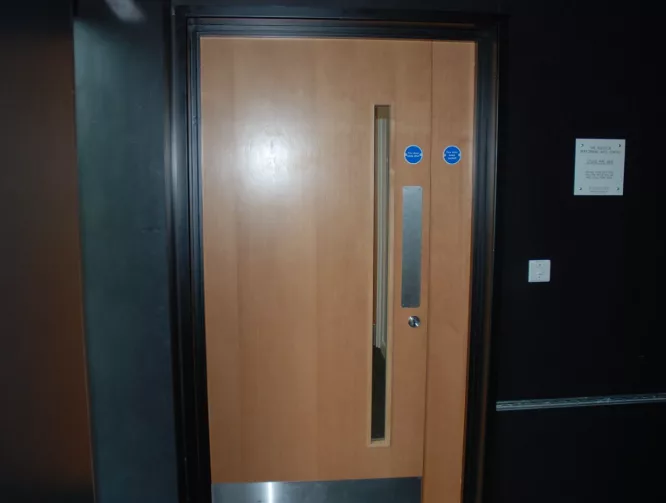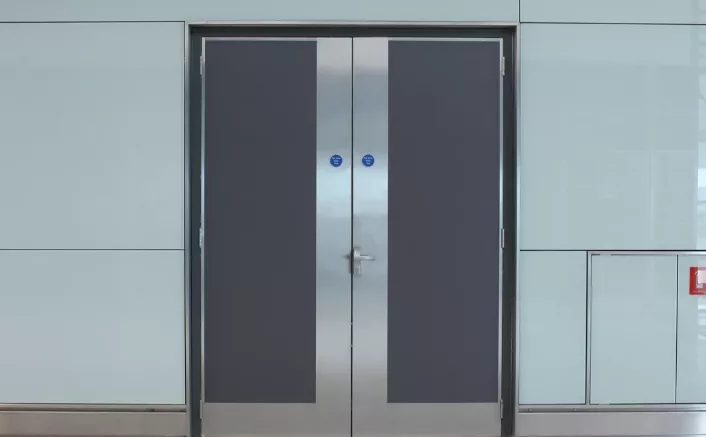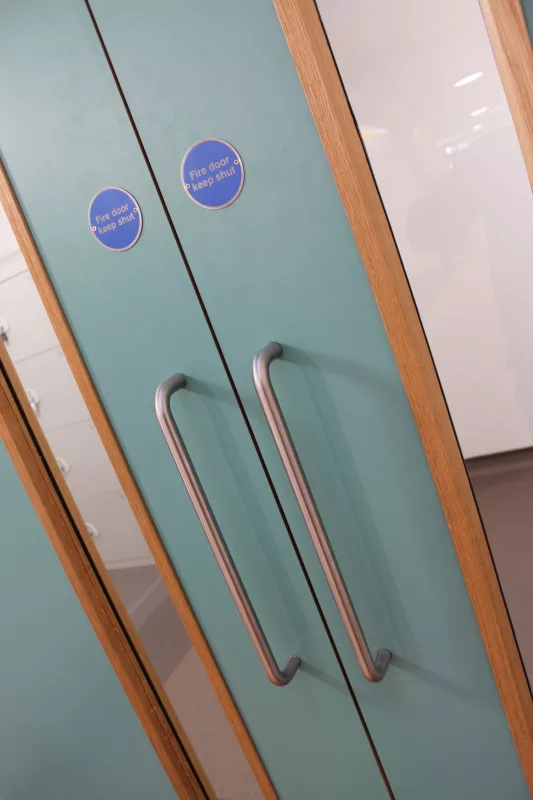Why the Question Matters — The Gap Between China and the UK Fire Door Standards
In the UK, a fire door isn’t just a product — it’s part of a legal safety system. Every component, from the core material to the hinges, must comply with BS 476 Part 22 or EN 1634-1 testing. These standards define how long a door can resist fire, how it should be installed, and how the entire assembly performs under extreme heat. Unlike many markets where certification is seen as an optional marketing tool, in Britain it’s a matter of law. A single missing label or non-approved seal can invalidate an entire project’s fire safety compliance.
Contractors in the UK are deeply aware of this. A failed fire door test doesn’t just mean lost money — it can halt an entire construction timeline. We’ve seen projects in London delayed for weeks because imported doors didn’t pass the BS test even though they performed well elsewhere. The problem isn’t that those doors were poorly made; it’s that British fire resistance testing focuses on complete door assemblies, not individual materials. Everything must work together — the leaf, frame, glazing, intumescent strips, and even the latch.
Understanding this gap matters for anyone looking to import fire doors into the UK. It’s not enough to say a door is “fire-rated.” It has to be tested and certified under the British system, witnessed by an accredited body such as Warringtonfire, BRE, or IFC Certification. For manufacturers, it means engineering doors specifically for that system, not just translating data from another region.
The UK’s approach may seem strict, but it’s built on a philosophy of prevention rather than tolerance. In real fires, a few minutes can decide the difference between damage and disaster — and those minutes are exactly what BS 476 and EN 1634 are designed to guarantee.
The Technical Reality — What It Takes to Build a BS-Compliant Fire Door
Material Science and Core Structure Differences
British compliance starts with the core. For 30–120-minute ratings, UK-bound timber doors typically use a high-density mineral core engineered to char slowly, hold shape, and keep hardware anchored under heat. It pairs with hardwood lippings, intumescent seals around the leaf and frame, and glazing systems with tested beads and tapes. The goal is assembly stability, not just a fire-resistant slab.
By contrast, many export-oriented doors elsewhere still rely on paper honeycomb or gypsum-based infills for standard projects. They’re light and inexpensive, but under BS/EN furnace conditions they can lose integrity sooner, struggle to hold screws once the adhesive softens, and transmit heat faster at fixings. That’s why UK designs prioritize:
- Mineral or composite cores with predictable thermal behavior
- Reinforced lock/latch zones that don’t crumble under load
- Seal architecture (intumescent + smoke) tuned to gaps and hardware
- Glazing kits tested with the exact glass, bead, and tape recipe
For Chinese factories, the practical solution is a dual-standard production line:
- Material lanes: racks for UK-spec cores, lippings, seals, and UK-sourced ironmongery, separated from domestic-spec stock to avoid cross-use.
- Programmable CNC + SOP sets: switchable drilling patterns (UK latch throws, hinge/backset geometry), different kerf widths for seals, and specific clearances for BS/EN gap tolerances.
- Batch traceability: each leaf/kit gets a unique code linking it to the exact bill of materials and ironmongery set used in the test program.
This is the heart of compliance: it begins at design and bill-of-materials, not at the certificate stage. If the core density, lipping thickness, glazing bead species, or intumescent profile deviates from the tested specification, the approval doesn’t follow the product—even if the paperwork looks tidy.
Testing and Certification — Who Approves a Door for the UK Market
In the UK, credibility comes from test evidence + controlled production. Doors are tested to BS 476-22 (legacy route) or EN 1634-1 (widely accepted route) as a complete assembly—leaf, frame, seals, glazing, hardware, and fixing method. The witness is an accredited body such as Warringtonfire, BRE, IFC, or UL UK. The lab selects the instrumentation, loads the door into the furnace, and records integrity/insulation performance to failure.
For Chinese manufacturers, there are two workable paths:
Path A — UK test, UK witness
- Build prototypes to the target rating (e.g., FD30/FD60).
- Ship assemblies (leafs, frames, vision panels, hardware) to a UK lab.
- Run the test. If it succeeds, commission an assessment/field of application to define allowed variations (sizes, hardware families, glazing limits).
- Set up an FPC (Factory Production Control) program so production stays aligned with the tested configuration.
Path B — Test at a lab recognized by the UK market
- Use an accredited lab with mutual recognition (UKAS-aligned acceptance).
- Ensure the report and classification document explicitly list the exact components and tolerances you’ll use in production.
- Pair this with third-party certification where required by the specifier (e.g., IFC or similar schemes) to strengthen acceptance on site.
A few hard truths buyers appreciate:
- The test is expensive and slow. A single BS 476-22 test can cost £6,000–£10,000 and last over 6 hours.
- Paper changes don’t count. Swapping a latch brand, glass type, or seal profile outside the field-of-application can void the evidence.
- Reports are not “universal passes.” They’re recipe-bound. Your on-site door must match the tested assembly in all critical aspects: core, lippings, gaps, glazing kit, hinges, latch/closer, seals, fixings, and installation method.
- Production must be auditable. UK contractors will ask for batch numbers, labels, and installation instructions that mirror the test build. No traceability, no trust.
What separates successful Chinese exporters from the rest isn’t low price; it’s discipline:
- Engineering teams that design for the test (not retrofit after failure).
- Supply chains that can source the exact UK-accepted components—often from UK/EU seal and glazing suppliers.
- QA systems that lock BOMs and tolerances, so every shipped door can be matched to the test dossier.
When these pieces are in place, passing a UK test stops being a gamble and becomes an engineered outcome.
How Chinese Manufacturers Adapt — From Export to Engineering
Collaboration with UK Consultants
The most capable Chinese fire door factories no longer treat export as a paperwork game; they treat it as engineering. When aiming for the UK market, many manufacturers partner directly with UK fire safety consultants to redesign their products from the inside out. These consultants—often retired testing engineers or certification specialists—advise on every detail that will appear under BS 476 or EN 1634 scrutiny.
A common first step happens during the prototype phase. A British consultant may recommend switching local sealing materials to recognized UK brands such as Lorient, Sealmaster, or Intumescent Seals Ltd.. The difference is more than branding: these seals expand predictably at 180–200°C, ensuring the door assembly passes the integrity criteria. In some workshops, engineers now keep side-by-side shelves of domestic and imported seals, comparing their expansion curves during mock tests.
This collaboration often extends to the design drawings. British partners will review CAD details—hinge spacing, glazing bead width, screw penetration depth—and flag issues that would fail the UK furnace test. It’s a back-and-forth process: Chinese engineers bring production practicality and cost control, while UK consultants bring regulatory nuance. Together they create a door that doesn’t just “pass once,” but can be produced repeatedly under audit conditions.
The conversations are rarely theoretical. Some UK consultants even visit factories in Guangdong or Zhejiang to observe assembly and document production control steps. Others connect through live video during pre-test mockups, advising in real time on gaps, seals, and frame fastenings. These hybrid collaborations are reshaping China’s fire door exports—making them smarter, not just cheaper.
Factory Process Upgrades for UK Projects

Compliance doesn’t end with the test report—it starts again on the production floor. For UK-bound orders, leading Chinese factories have introduced traceability and quality audit systems similar to those required by British certification bodies. Every door leaf now carries a laser-engraved serial number, linked to a batch report listing the core material, seal brand, glass code, and hardware lot number. If a contractor in Manchester questions a hinge or label, the manufacturer can trace it to the day and shift of production.
Workshops once managed by handwritten notes now run on digital checklists. At the final inspection stage, each door is weighed, its gaps are checked with calibrated feeler gauges, and photographs are archived to prove conformance. Even packaging is standardized—corner protectors, barcodes, and sealed export cartons that match the shipment manifest for audit traceability.
This shift wasn’t easy. In some parts of the industry, corner-cutting still exists—thin core boards, recycled seals, missing test labels. These practices keep short-term costs down but destroy long-term credibility. Many buyers learn too late that a door labeled “BS tested” doesn’t mean it’s BS-compliant in production.
That’s why genuine manufacturers now invite buyers and contractors to visit the factory. Walking through a plant tells you everything: the smell of fresh adhesive, the stack of sealed cores, the organized testing wall covered with calibration certificates. A responsible supplier welcomes scrutiny because it proves consistency.
From a long-term view, choosing a manufacturer with responsive service, transparent processes, and verifiable test lineage is worth more than saving a few dollars per door. The British market rewards reliability, and so do real-world fires. In an emergency, a door either holds or it doesn’t—and that truth can’t be negotiated on price.
Common Misconceptions About Exporting Fire Doors to the UK

“If It Passes EN 1634, It’s Automatically UK Approved” — Not Always
Many suppliers believe that passing EN 1634-1 automatically guarantees UK approval. It sounds logical—both BS 476 and EN 1634 measure fire resistance and integrity. But in practice, the UK regulatory environment interprets test results through Building Regulations Part B, which applies a much tighter view of what counts as compliant.
Under Part B, a door’s approval depends on three layers:
- Test performance — whether it passes EN or BS furnace testing.
- Certification recognition — whether the test report was issued by a UKAS-accredited or mutually recognized laboratory.
- Installation equivalence — whether the tested configuration (gaps, lippings, seals, frame fixings) matches what’s being installed on-site.
This last part catches many exporters by surprise. UK inspectors often reject doors that technically “passed EN testing” but differ in gap tolerances, hinge placement, or frame density from the tested sample. The British system is strict because the door assembly, not just the leaf, defines performance. Even the type of screws or frame anchoring method can determine whether a door survives the required 30 or 60 minutes.
Another nuance: EN 1634 allows flexible installation methods suited to European construction styles, while BS 476 and UK certification schemes require closer tolerances for timber subframes, fire-stopping materials, and seal compression levels. In short, EN testing is valuable, but it isn’t an automatic ticket to UK compliance. For real acceptance, the door must be tested, certified, and installed under the same conditions defined by UK regulators.
“Chinese Doors Are Cheap but Fail Tests” — Quality Depends on Process
There’s a long-standing assumption that low-cost Chinese fire doors can’t meet UK standards. In reality, the quality gap isn’t about geography—it’s about process discipline. A growing number of Chinese factories now hold EN 1634, UL 10C, and BS 476 certifications simultaneously. These manufacturers have invested in dual testing programs and maintain strict Factory Production Control systems monitored by external auditors.
The reason Chinese doors remain more affordable has less to do with cutting corners and more with structural economics. Labor costs, energy rates, and raw material sourcing in China are significantly lower than in Western Europe. A skilled factory worker in Zhejiang might earn in a month what an equivalent operator in Birmingham makes in a week. Yet the machinery and materials—CNC routers, intumescent seals, mineral cores—are often identical.
There’s also a hidden factor: industrial competition. China’s fire door industry is saturated, and factories must fight for international contracts. This has driven them to raise quality standards while keeping margins thin. The result is a unique combination—high technical competence at globally competitive prices.
For British buyers and contractors, this means a well-chosen Chinese supplier can deliver doors that meet BS or EN standards at 30–50% lower overall cost, without compromising safety. The difference lies in selection: choosing a manufacturer with traceable testing, transparent communication, and verified production control. When those elements align, “Made in China” no longer implies risk—it represents efficiency refined through pressure.
Case Study — A Real Project That Passed BS Testing

When we first received the inquiry for a hospital project in Manchester, the client’s request was simple on paper yet demanding in practice: “We need a 60-minute fire door set fully compliant with BS 476 Part 22.” For us, that meant more than sending a catalog — it meant engineering a door system from scratch, under a standard we had to meet line by line.
We began by building three prototype assemblies, each with slightly different core densities, seal combinations, and hinge placements. The first two tests failed at 47 and 53 minutes, just shy of the 60-minute target. It was frustrating, but also instructive. After revising the lipping thickness and switching to a UK-sourced intumescent strip from Lorient, the third sample held for 64 minutes under full furnace exposure at Warringtonfire. The test engineer noted in his report that the latch area and glazing bead performance were “stable and consistent throughout the heating period.” That single sentence made months of effort worthwhile.
The testing success opened another challenge: communication and coordination. We had multiple Teams meetings with the UK consultants and project managers, sometimes late at night due to the time difference. Small things became big hurdles — Chinese engineers often couldn’t register Outlook accounts for meeting invites, so our technical team in China created each Teams session manually and invited the UK counterparts. Despite such trivial barriers, we handled them carefully, knowing that professional communication builds as much trust as a passed test report.
The collaboration was more than technical; it was cultural. Our engineers learned how British consultants document deviations, how they prefer detailed batch photos before shipment, and how they interpret the difference between “tested” and “approved.” On their side, the British team appreciated our responsiveness — we often sent revised CAD drawings overnight to keep their review schedule on track.
Logistics brought another layer of complexity. We discussed several shipping options before selecting Shanghai Port, balancing freight rates, distance, and reliability. Every door set was labeled, documented, and packed in moisture-proof crates with inspection reports inside. The buyer’s terms were milestone-based — 30% upon approval, another 30% after port loading, 30% post-discharge, and the final balance after on-site acceptance. Each stage moved smoothly because both sides respected deadlines and documentation.
In the end, the doors arrived, passed the final inspection in Manchester, and were installed across multiple hospital wards. Seeing photos of those finished corridors — with our fire doors fitted perfectly — felt deeply satisfying. We had not only exported a product but also built a bridge of trust and discipline across continents.
For us, the lesson was clear: achieving BS compliance isn’t just about the test. It’s about collaboration, respect for standards, and understanding that service and quality share equal weight. British clients are rigorous but fair; when they see that same rigor reflected in a Chinese partner, cooperation becomes effortless — and enduring.
The Future — Can China Become a Certified Fire Door Hub for the UK?
Establishing UK Testing Partnerships in China
Over the past decade, British testing institutions have slowly extended their presence into China. Warringtonfire Shanghai and UL Solutions Suzhou are early examples of what the next generation of global fire safety collaboration looks like. These local testing branches operate under UKAS recognition, allowing certain BS or EN tests to be witnessed and validated within China — saving manufacturers weeks of shipping time and thousands in logistics costs.
For Chinese factories, this marks a shift from “exporting to comply” to “producing within compliance.” Instead of sending prototypes across continents, they can now coordinate furnace tests, witness inspections, and post-test analyses within a few hours’ reach. This proximity allows for faster iteration — adjusting core density, seal geometry, or glazing layout — and retesting under the supervision of engineers who understand both the British and Chinese technical languages.
The presence of these UK testing partnerships also cultivates a new manufacturing mindset. It’s no longer about chasing certificates for one-off projects; it’s about embedding certification-grade discipline into the everyday workflow. More Chinese factories are creating in-house test furnaces for mock trials, building documentation teams trained to UK audit standards, and hiring bilingual engineers who can translate BS clauses directly into factory SOPs.
In essence, the future of BS-compliant manufacturing in China may not depend on paperwork issued abroad — it may grow from UK-certified labs operating within China, creating a bridge where expertise and production coexist on the same ground.
Towards a Unified Fire Safety Standard
Looking ahead, there’s a quiet but steady movement toward global alignment in fire door testing. The differences between BS 476, EN 1634, and China’s GB/T standards are narrowing as international collaboration deepens. While full equivalence isn’t yet in place, the technical community has begun discussing harmonized benchmarks for furnace calibration, thermocouple placement, and failure criteria — the key ingredients that determine whether a fire test is comparable across borders.
Under initiatives such as the Belt and Road framework, China has been signing bilateral agreements that encourage mutual recognition of safety testing and certification. In the long term, this could mean that a door tested in Shanghai or Guangzhou under a UK-supervised protocol might be recognized in both European and British markets. Such developments would dramatically reduce testing duplication and improve global supply efficiency.
For manufacturers, the convergence of standards represents more than convenience — it’s an evolution toward trust-based engineering. A world where “tested in China” no longer raises eyebrows but signals competence and transparency.
And perhaps, one day, British architects will specify a door tested in China without hesitation — not because it’s cheaper, but because it meets the same rigorous benchmark they trust at home. When that happens, China will no longer just be the world’s workshop; it will stand as a certified fire door hub for the global market.
Conclusion — The Bridge Between East and West in Fire Safety
In the end, the difference between Chinese and British fire door standards is not a barrier — it’s a bridge. Certification isn’t a wall separating two markets; it’s a structure that connects them through precision, transparency, and trust. Every tested door, every joint video meeting, and every line of technical dialogue brings that bridge a little closer to completion.
The story of fire door manufacturing between China and the UK is really a story about collaboration. On one side stands a nation with vast production capability and relentless efficiency; on the other, a market that prizes documentation, accountability, and proven performance. When these strengths align, the result isn’t compromise — it’s progress.
We’ve seen it firsthand: engineers from both sides refining prototypes together, testing labs sharing data, consultants crossing time zones to ensure clarity. This is the new face of global fire safety — not competition, but cooperation built on shared responsibility.
The standards may differ, but the goal is the same: to protect lives and property with doors that stand firm when everything else fails. As Chinese manufacturers continue to evolve and UK institutions extend their reach eastward, the bridge between East and West grows stronger — forged by heat, tempered by discipline, and held together by trust.

